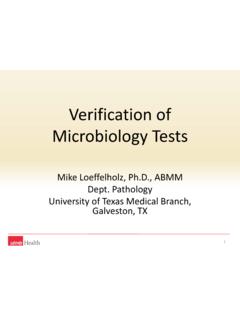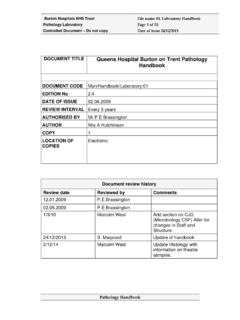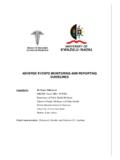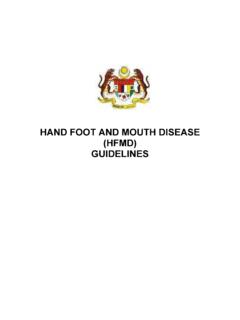Transcription of SENTINEL LEVEL CLINICAL LABORATORY GUIDELINES
1 SENTINEL LEVEL CLINICAL LABORATORY GUIDELINES FOR SUSPECTED AGENTS OF BIOTERRORISM AND EMERGING INFECTIOUS DISEASES Bacillus anthracis American Society for Microbiology (ASM) Revised July, 2013 For last revision, see website below ASM Subject Matter Experts: Alice Weissfeld, James W. Snyder, Microbiology Specialists, Inc. University of Louisville Houston, TX Louisville, KY ASM SENTINEL LEVEL LABORATORY Protocol Working Group APHL Advisory Committee Vickie Baselski, University of Tennessee at Memphis Memphis, TN David Craft, Penn State Milton S. Hershey Medical Center Hershey, PA Peter H. Gilligan, University of North Carolina Hospitals/ CLINICAL Microbiology and Immunology Labs Chapel Hill, NC Larry Gray, TriHealth Laboratories and University of Cincinnati College of Medicine Cincinnati, OH Major Todd Kijek, US Army Medical Research Institute for Infectious Diseases Ft.
2 Detrick, MD Michael J. Loeffelholz, Department of Pathology Univ. Texas Medical Branch Galveston, TX Judith C. Lovchik, Indiana State Department of Health Laboratories Indianapolis, IN Scott W. Riddell, Department of Pathology SUNY Upstate Medical University Syracuse, NY Barbara Robinson-Dunn, Department of CLINICAL Pathology Beaumont Health System Royal Oak, MI Michael A. Saubolle, Banner Health System Phoenix, AZ Susan L. Shiflett Michigan Department of Community Health Lansing, MI Alice Weissfeld, Microbiology Specialists Inc. Houston, TX David Welch, Medical Microbiology Consulting Dallas, TX Mary K. York, MKY Microbiology Consultants Walnut Creek, CA Coordinating Editor: James W.
3 Snyder, University of Louisville Louisville, KY Administrative Support Kimberly E. Walker, American Society for Microbiology Patricia Blevins, MPH San Antonio Metro Health District LABORATORY Erin Bowles Wisconsin State LABORATORY of Hygiene Christopher Chadwick, MS Association of Public Health Laboratories Mary D eMartino, BS, MT(ASCP)SM State Hygienic LABORATORY at the University of Iowa Harvey Holmes, PhD Centers for Disease Control and Prevention Kara MacKeil Association of Public Health Laboratories Chris Mangal, MPH Association of Public Health Laboratories Amanda Moore, BS South Carolina Department of Health and Environmental Control James Rudrik, PhD, Michigan Department of Community Health Maureen Sullivan, MPH Minnesota Department of Health PREANALYTICAL CONSIDERATIONS I.
4 PRINCIPLE A. Introduction Bacillus anthracis, the agent of anthrax, is a zoonotic disease that is transmissible to humans through consumption or handling of contaminated products, is an aerobic, spore-forming, nonmotile, large Gram-positive bacterium (3). It is classified as a Tier I, Category A agent because of its suitability for use as a biothreat agent in an attack or commission of a biocrime. This procedure describes steps to recognize, presumptively identify, and rule out this organism in CLINICAL specimens in SENTINEL CLINICAL Laboratories. Such laboratories are defined as those who are certified to perform high complexity testing under the CLINICAL LABORATORY Improvement Amendment of 1988 (CLIA 88) by the Centers for Medicare and Medicaid Services (CMS) for the applicable Microbiology specialty.
5 LABORATORY in-house testing includes Gram stains, and at least one of the following: lower respiratory tract, wound, or blood cultures. SENTINEL CLINICAL laboratories are not required to register with the Select Agent Program to conduct diagnostic testing for Select Agents, both Tier I and non-Tier 1. Testing for Select Agents may be performed by laboratories as long as the LABORATORY follows the policies listed in the reporting section of this document when a Select Agent cannot be ruled out. Consult with your designated LRN Reference LABORATORY or refer to the CDC Division of Select Agents and Toxins website at for questions. NOTE: To rule out B. anthracis requires a combination of morphological assessment including Gram stain characteristics, and three simple, conventional tests.
6 Automated systems and manual multi-test kit identification methods have no place in the identification of this organism due to the danger of misidentification and its close relationship to other species within the Bacillus genera. B. Geographic distribution Anthrax is endemic in southern Europe, parts of Africa, Australia, Asia, and North and South America. Its persists in arid deserts of the Middle East, Asia, Africa, Australia and South America with the majority of cases reported from Iran, Turkey, Pakistan, and Sudan. Although relatively rare in the United States, over 500 cases in Texas were reported in White Tailed Deer since 2006. Cases have also been reported in livestock in South Dakota, Nebraska, Arkansas, Mississippi, Louisiana, and California.
7 The use of B. anthracis as a bioterrorism agent to inflict disease and death following contact with or inhalation of spores has dominated recorded history for centuries (5, 17). Primarily used by many countries, including the United States, for military purposes in the conduct of biowarfare, it gained notoriety in the commission of biocrimes, determined to be hoaxes, throughout the 1990s. Although the LRN was created in late 1999, its role and responsibilities in preparing for, and responding to bioterrorism increased dramatically during and after the 2001 outbreak. The lessons learned from this national event demonstrated the serious need for training SENTINEL LEVEL CLINICAL Laboratories and preparing them to play a key role in the LRN.
8 Three naturally occurring cases of anthrax have been reported within the past five years, one case respectively of gastrointestinal, cutaneous, and inhalational (18, 20, 21). These incidences are examples in which SENTINEL LEVEL CLINICAL Laboratories will be challenged by ensuring that all suspicious Bacillus spp., have been ruled out based on the use of the LRN designated tests and algorithm for B. anthracis discussed in this protocol. C. Diseases and CLINICAL Presentation Anthrax is a zoonotic disease that occurs most frequently in herbivorous animals ( , cattle, sheep, and goats), which acquire endospores from contaminated soil. Human disease is less common and results from contact with infected animals or with commercial products derived from them, such as wool and hides.
9 Infection can occur in one of three forms: 1. Cutaneous, responsible for >95% of naturally occurring cases, is initiated when the bacterium or spores enter the skin through cuts or abrasions, such as when handling contaminated hides, wool, leather, or hair products (especially goat hair) from infected animals (1, 13, 20). Skin infection begins as a raised itchy bump or papule that resembles an insect bite. Within 1 to 2 days, the bump develops into a fluid-filled vesicle, which ruptures to form a painless ulcer (eschar), usually 1 to 3 cm in diameter with a characteristic black necrotic area in the center. Pronounced edema if often associated with lesions to the releases of edema toxin, a major virulent factor produced by the organism.
10 Lymph glands in the adjacent area may also swell. Approximately 20% of untreated cases of cutaneous anthrax result in death either because the infection becomes systemic or because respiratory distress caused by edema in the cervical and upper thoracic regions. Deaths are rare following appropriate antimicrobial therapy, with lesions becoming sterile within 24 h and resolving several weeks later. There are a few case reports of transmission by insect bites, presumably after the insect fed on an infected carcass (22). 2. Gastrointestinal anthrax may occur 1 to 7 days following consumption of contaminated undercooked meat from infected animals and is characterized by acute inflammation of the intestinal tract. Initial signs of nausea, loss of appetite, vomiting, and fever are followed by abdominal pain, vomiting of blood, and severe bloody diarrhea.






